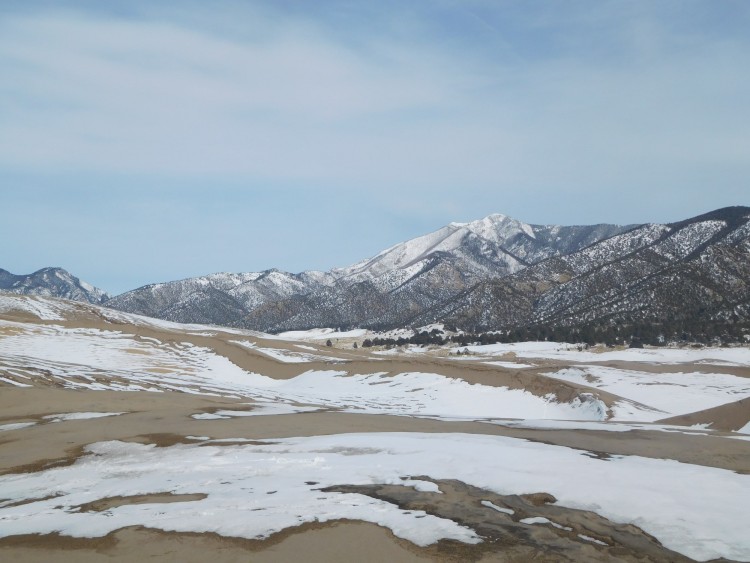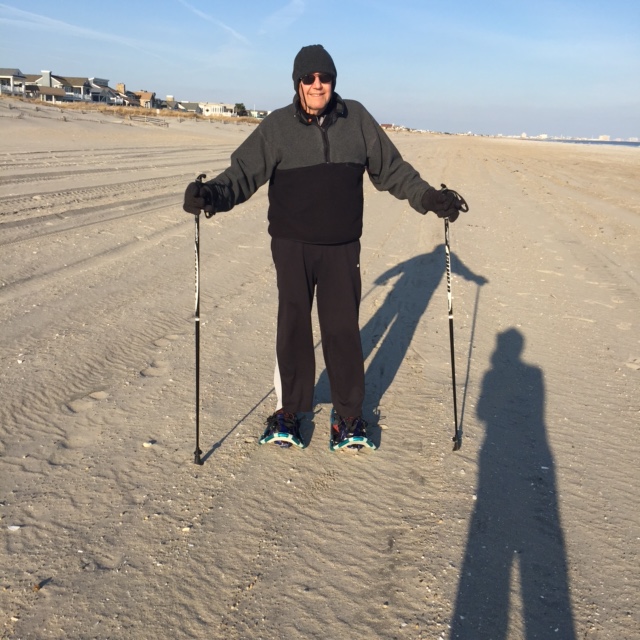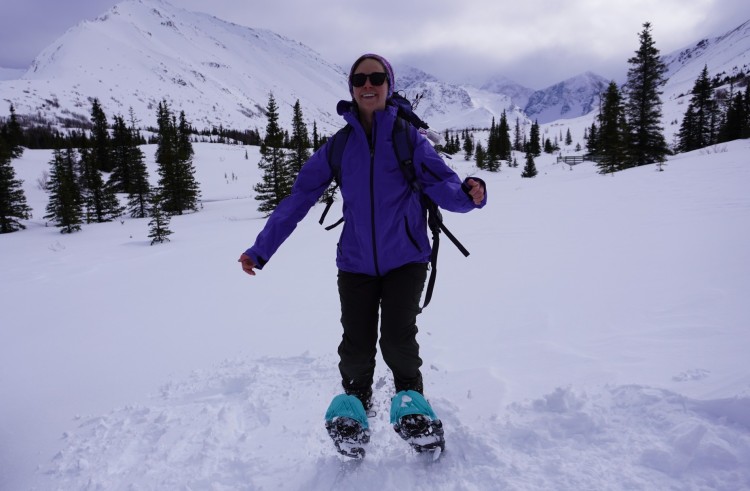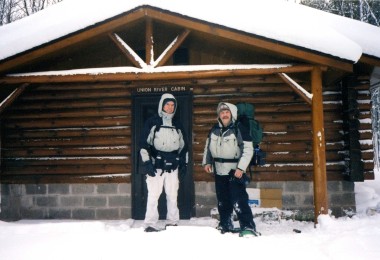The snow: Is there anything like it? Well, maybe. There might be a new medium out there to test out your snowshoes – sand. Even though sand and snow have different properties, there are many ways in which they’ve been categorized together.
Photographers and artists have seen the connections between the two for years. Take artist Simon Beck. He began as a snow artist, creating gorgeous and minutely detailed geometric and architectural works in the snow. But, he also creates detailed works in the sand, a similar canvas to the snow.
The same is true in many snow sports. Have you ever heard of sandboarding, sand sledding, or sand-skiing? It is a thing (a fun thing from the looks of it). Dunes and parks, including Great Sand Dunes National Park in Colorado, regularly host sand sport enthusiasts. Sandshoeing or using snowshoes on the sand is part of this group.
Some of the links in this article may contain affiliate links. When you make a purchase using these links, part of the proceeds go to Snowshoe Mag. Additionally, as an Amazon Associate, we earn from qualifying purchases. Please see our disclosure for more details.
Why Use Snowshoes on Sand
Snowshoes were originally designed to provide floatation or to limit sinking in the snow. In fact, nothing can ruin a snow outing more than post-holing the whole way up the trail. In addition to floatation, snowshoes provide stability and grip on the snow, especially in uneven snow and melting spring snow.
Whether the dunes or the beach, walking in the sand is similar, with problems snowshoes can solve. So, the next time you’re on the beach or the dunes, consider the benefits and fun that using snowshoes on sand can provide.
Richard Linell, an avid sandshoer, former football coach, and competitive biathlon competitor, shares his favorite reasons for getting out on the sand.
Great Workout
His primary reason is sandshoeing, just like snowshoeing is a great workout!
Even without snowshoes, the resistance of the sand causes your body to work harder than you would on flat ground. Many avid beach athletes and enthusiasts know this fact.
But, add snowshoes to your feet, and the extra weight offers an increased challenge, especially for your lower body. For the upper body, you can use Nordic walking poles (Richard likes Exerstrider or Leki non-collapsable poles like the Passion) to increase the workout.
Read More: Walk Your Way Into Snowshoeing for Improved Fitness with Nordic Walking Poles
Stability
The second benefit Richard mentioned is stability. The snowshoe’s flat layout provides balance on uneven terrain, and the snowshoe binding protects your foot and keeps it secure. You don’t have to worry about any ankle shifting or risk losing your balance while on the sand, especially if you sandshoe with poles.
Granted, you’re not going to need the grip provided by the snowshoe crampons. Still, you will appreciate the extra stability and foot protection the snowshoe offers on the sand.
Read More: Snowshoeing Education: Are Two Poles Better Than One?
New Medium
It can be boring or tiresome always to do the same routine. One way to change up what you do is to change the medium. As Richard says, “A lot of people are looking to get outside and want a change. You can look out of the box at doing things”.
So, swap out the snow for sand to offer a completely different experience on snowshoes!
Year-Round Activity
One of the saddest times of the year for us snowshoers is when the snow disappears. Even though spring can be a pleasant change of scenery, winter will always be (at least for me) the favorite season because of the snowshoeing opportunities that it brings.
However, by using our snowshoes on the sand, we have the opportunity to enjoy the activity all year round! As Richard mentions, “Beaches don’t go away, and they’re good for your psyche.” So, no matter the season, sandshoeing offers an escape to breathe in the fresh air with our favorite outdoor equipment (a.k.a snowshoes).
Limit Sinking
Richard does his sandshoeing on the beach, but if you’re headed out to the dunes with deep sand, snowshoes can also improve your floatation. Especially on moderate or relatively flat dunes, snowshoes can limit your sinking in deep sand. Just ask this writer who used their snowshoes on the sand at the White Bluffs in Washington state.
Read More: Why Wear Snowshoes?

If you want to try sandshoeing on dunes (like these at Great Dunes National Park), the snowshoes may help limit your sinking. Photo: Susan Wowk
Snowshoe Recommendations & Maintenance
Richard uses a pair of aluminum Crescent Moon snowshoes that he’s had for almost a decade. However, our primary snowshoe recommendation for your sandshoeing outings is Crescent Moon’s Eva Foam snowshoes.
The beauty of the Evas is they feel like an extension of your foot, are relatively lightweight, and are easy to use. Plus, Crescent Moon built these snowshoes for packed conditions, foam is less prone to wear and tear, and the snowshoes don’t have stainless steel or aluminum crampons underneath, only small rubber cleats that provide traction. The small rubber cleats allow you some grip without the threat of wear and tear on your crampons. Also, aggressive traction may not provide the grip you’re looking for on steep slopes.
Also, speaking of wear and tear, since sand and saltwater can be tough on the ‘shoe, be sure to clean your snowshoes thoroughly after each outing to help preserve them.
First, inspect your snowshoes for grains of sand. As small as they are, grains of sand may get stuck on your ‘shoes, especially in the binding components. Wipe off any sand that you find stuck or embedded in your ‘shoes to help prevent wear and sand build-up. Then, rinse off your snowshoes with fresh water to remove any sand that you’ve missed. A thorough wash will help your equipment last longer and is essential if you happened to get any saltwater on your snowshoes since saltwater is corrosive. Finally, make sure that you’re storing your snowshoes appropriately.
If you don’t have snowshoes of your own to try out on the sand, you can rent them from most local sporting goods stores. Or, coming soon, rent them directly from Snowshoe Magazine (let us know if you’re interested).
Read More: Crescent Moon Eva Snowshoes Review: A Unique Experience
Go Out & Try It!
So, next time you’re out on the beach or headed to the dunes, try bringing along a pair of snowshoes with you to use on the sand. Whether your goal is fitness or protection or trying a different activity, sandshoeing is the way to go.
What about you? Have you tried using your snowshoes in the sand or sandshoeing? Would you? Please share your experiences with us in the comments below.
This article was corrected on April 1, 2021, to clarify the snowshoes used in Richard’s sandshoeing experiences.
Read Next:
The Sandshoeing Days of Summer
Definitive Guide: How to Choose the Perfect Snowshoes for Your Needs
Reap the Health Benefits of Snowshoeing
Snowshoeing for Beginners: The First-Timer’s Guide








I do sandshoeing 3-4 times per week and love it.
I would definitely give it a try if sand dunes were near me.
Thanks for sharing, Greg! Hopefully, you will have the opportunity to try some time 🙂